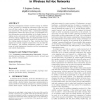Free Online Productivity Tools
i2Speak
i2Symbol
i2OCR
iTex2Img
iWeb2Print
iWeb2Shot
i2Type
iPdf2Split
iPdf2Merge
i2Bopomofo
i2Arabic
i2Style
i2Image
i2PDF
iLatex2Rtf
Sci2ools
120
Voted
IPSN
2004
Springer
2004
Springer
Naps: scalable, robust topology management in wireless ad hoc networks
Topology management schemes conserve energy in wireless ad hoc networks by identifying redundant nodes that may turn off their radios or other components while maintaining connectivity. We present Naps, a randomized topology management scheme that does not rely on geographic location information, provides flexibility in the target density of waking nodes, and sends only a periodic heartbeat message between waking neighbors; thus it is implementable even on modest hardware. We formally analyze the connectivity of the waking graphs produced by Naps, showing that these graphs have nearly complete connectivity even at relatively low densities. We examine simulation results for a wide range of initial deployment densities and for heterogeneous and mobile deployments. Categories and Subject Descriptors C.2.1 [Computer-communication Networks]: Network Architecture and Design—distributed networks, network topology, wireless communication General Terms Algorithms, Performance, Theory Keywo...
IPSN 2004 | Sensor Networks | Topology Management | Topology Management Scheme | Wireless Ad Hoc Networks |
Related Content
| Added | 02 Jul 2010 |
| Updated | 02 Jul 2010 |
| Type | Conference |
| Year | 2004 |
| Where | IPSN |
| Authors | Brighten Godfrey, David Ratajczak |
Comments (0)

